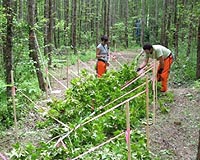| . |  |
. |
Menlo Park CA (SPX) Aug 03, 2009 Large trees have declined in Yosemite National Park during the 20th century, and warmer climate conditions may play a role. The number of large-diameter trees in the park declined 24 percent between the 1930s and 1990s. U.S. Geological Survey and University of Washington scientists compared the earliest records of large-diameter trees densities from 1932-1936 to the most recent records from 1988-1999. A decline in large trees means habitat loss and possible reduction in species such as spotted owls, mosses, orchids and fishers (a carnivore related to weasels). Fewer new trees will grow in the landscape because large trees are a seed source for the surrounding landscape. Large-diameter trees generally resist fire more than small-diameter trees, so fewer large trees could also slow forest regeneration after fires. "Although this study did not investigate the causes of decline, climate change is a likely contributor to these events and should be taken into consideration," said USGS scientist emeritus Jan van Wagtendonk. "Warmer conditions increase the length of the summer dry season and decrease the snowpack that provides much of the water for the growing season. A longer summer dry season can also reduce tree growth and vigor, and can reduce trees' ability to resist insects and pathogens." Scientists also found a shift to fire-intolerant trees in some forests that had not experienced fires for nearly a century. In these areas, trees changed from fire-tolerant ponderosa pines to fire-intolerant white fir and incense cedar. In burned areas, however, pines remained dominant. "We should be aware that more frequent and severe wildfires are possible in Yosemite because of the recent shift to fire-intolerant trees in unburned areas and warmer climates bring drier conditions," said van Wagtendonk. Share This Article With Planet Earth
Related Links US Geological Survey Forestry News - Global and Local News, Science and Application
 Forest Response Project FACEs The End
Forest Response Project FACEs The EndOak Ridge TN (SPX) Jul 30, 2009 After 12 years, an experiment focused on forest growth and climate change comes to an end, and researchers at Oak Ridge National Laboratory are eager to collect and analyze data to see if their predictions match results. With the Department of Energy-sponsored free air carbon dioxide enrichment experiment, known as FACE, three plots of sweetgum trees were the control sites and two plots of ... read more |
|
| The content herein, unless otherwise known to be public domain, are Copyright 1995-2009 - SpaceDaily. AFP and UPI Wire Stories are copyright Agence France-Presse and United Press International. ESA Portal Reports are copyright European Space Agency. All NASA sourced material is public domain. Additional copyrights may apply in whole or part to other bona fide parties. Advertising does not imply endorsement,agreement or approval of any opinions, statements or information provided by SpaceDaily on any Web page published or hosted by SpaceDaily. Privacy Statement |